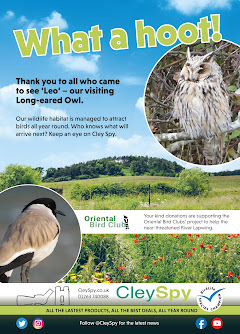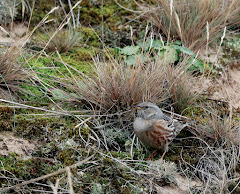Mark Golley very kindly emailed me the following:
'The news of a possible Pacific Diver on the sea off Titchwell RSPB during the bright, calm but chilly, afternoon of January 3rd certainly stirred a few, nervous New Year flutters along the north Norfolk coast. If the bird was still in place, it was worth a setting sun scurry along the A149, so Steve Beal and I set off, expecting some sort of news en route from Cley. None came, and no one we passed as we headed along the Titchwell looked in the remotest bit excited. Steve and I imagined that the bird had moved on, but as we reached the beach, a small gathering on the water's edge, and a phone call from Penny, confirmed that the bird was actually still in situ.
Almost as soon as we had set up our 'scopes, the bird resurfaced. It was fairly distant and the initial impressions were of a striking, contrasting black and white medium sized (but still robust) Gavia, with undeniably darkish flanks and a curious (atypical for Pacific Diver) headshape - a slight front heavy bump on the forehead, a flat crown and slight bump at the rear. My first thoughts, once the bird submerged gracefully, was that yes, it was interesting but how could it be a Pacific Diver with a head shape like that?
I have to say know that my experience of Pacific Diver is, like many others limited. I'd seen a few in the dim & distant past in California and there was the marvellous juvenile in North Yorkshire in the early part of 2007. This bird bore, to my eyes, no real resemblance to the Farnham GPs bird.
The bird continued to perform, in decent light, but distantly, for the next 10-15 minutes or so (maybe longer) and thoughts that the bird lacked the so-called "chin-strap" shown by many Pacific Divers - were confirmed by other folk on site, Dave Hawkins saying that the finder was positive that there was no strap. Of course, this isn't a problem, as the popular identification literature states that as many as 50% of juveniles (winter birds as a whole?) lack this popular identification feature.
There was, when roll-preening, a suggestion of a ventral strap (shown by Pacific Diver, but also a feature seemingly shared (to one degree or another) by Black-throated and Great Northern Divers (Lars Jonsson illustrates this very feature not only in his field guide "The Birds of Europe" but also in his marvellous Swedish language book on divers "Loomar").
One of the most striking features of this curious thing was the wholly dark flanks. At no time in the period of 30-40 minutes observations, at various distances and light conditions, did this bird show any suggestion of the diagnostic white rear flank patch of Black-throated Diver (whether swimming, diving or preening). Again, those present longer than us were also sure of this and again, DH said that the finder, who had watched the bird for at least an hour or two, was adamant that the flanks were dark and dusky. So, a great Pacific Diver feature!
The face pattern didn't (to my eyes) match that often shown by Black-throated Diver, closer to the dusky look of a Pacific, but I thought that it was perhaps even more extensively dusky, compared to images I've seen of other Pacific Divers. Odd. And I didn't see any contrast on the sides of the neck (at the lower end) as I had done with the Farnham bird.
At one point, when the bird was head on (again distant), I thought I saw some smudged breast patches. These were most reminiscent of a Great Northern Diver and the odd headshape made me wonder if it could actually be a strange, black and white, small-billed Great Northern. Unlikely I suspect. I've never seen a "small" or emaciated Great Northern Diver, and I'd seen the beautiful juvenile at Whitlingham Lane the day before. Despite a brief (personal) attempt to crow bar it in to that immer box, it didn't work. (For now at least!)
So. Back to Black-throated or Pacific. In the, rather delicious, sunset, the bird had steamed closer and closer inshore. It had started drifting west and as it headed that way,it started to draw nearer and nearer. I walked along the tideline, stopping every so often to latch on to the bird again (easy of the flat sea). Steve joined me and the bird eventually ended up just behiond the slender breakers. By now the light was failing, but some scaling was apparent on the upper part of the upperparts (if you follow), but they didn't seem as extensive as the juvenile at Farnham. And it was (in the light of the day) much more contrastingly black and white. The circumstances, once again, were very different - a bird close on a lake in Yorkshire in the flat calm and perfect light is very different to a bird offshore in Norfolk, in the last light of the day. But, all that beside, I'm guessing that the bird is a juvenile (although quite what degree of scaling a second-winter bird would show is something I've not checked).
The head shape was still giving me a huge cause for concern in terms of Pacific Diver, likewise the lack of the "puffy" nape/neck (shown so wonderfully by the Farnham bird). The bill continued to throw me too - sometimes looking larger than I expected, on other occasions looking suitably "thorn-like" and ok for a bird in the Black-throated/Pacific camp.
Eventually, the light failed and so did any hopes of a nailed on, cast iron, identification. There are elements that fit Pacific Diver. Equally, crucially, there are elements that don't fit the text book Pacific Diver.
I know that the bird was again off Ticthwell on the Monday (4th) and then Brancaster on the Tuesday (5th). With the weatehr turning breezy again, its going to be a struggle to find off Titchwell and environs until calmer conditions come in again.
As if by magic, the Channel Islands first ever Pacific Diver was identified on the very same day as the Titchwell bird was seen. The shots show a classic juvenile Pacific Diver. Markedly different from the bird in Norfolk (certainly where the head shape, overall gentleness, puffy neck are concerned). However, the flanks look just the same!
This stream of conciousness comes to the conclusion is who knows what the Titchwell diver is! I'd love it to be the county's first, the east coast's first. Its a fascinating bird, throwing up several questions (not least the safe separation of Great Northern Diver from the Black-throated/Pacific twosome). Another, slightly more fanciful, question is just where do those adult Pacific Divers go in the summer, what could they be mating with and what would their offspring look like....not a cop-out, honest! A genuine query.
Far play to the original observer for being brave enough to pop their head over the, increasingly hostile, paraphet and draw people's attention to this fascinating bird. The learning curve seems to become a tad steeper again.
Here's hoping some sharp eyes pick it up in the days to come and it surrenders to a lens or two.
Mark Golley
Cley, Norfolk
07/01/10'
Subscribe to:
Post Comments (Atom)








































I like this site!
ReplyDeleteAn excellent well balanced report. Mark's final comment on the finder bravely putting the bird out is something I agree with.
On Sunday 2 January I saw the Lowestoft black-throated diver even though the pager and Suffolk Bins website said the bird was not seen. Having reported my sighting to the Lowestoft "Lounge Lizard" birders others saw the bird this week.
Oh and your Norfolk list for 2009 was very good, Penny.
I try to see as many species in a year as I can conveniently get to. Did not travel to the great spotted cuckoo on the first day, after work, having cycled in. Saw the Cart Gap bird. Dipped the cuckoo the next day and was away later in its stay so did not see it at all!
PAUL
Thank you Paul.
ReplyDeleteWon't be doing a list this year - just going to enjoy birding, but will of course go to see any rares!!!
Mark is an excellent writer.
Penny